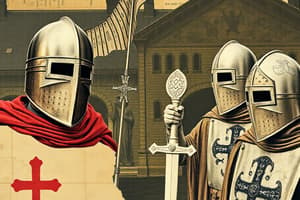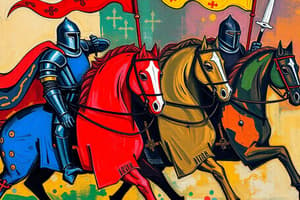Podcast
Questions and Answers
Which architectural feature of Valletta, constructed by the Knights of St. John, was most crucial for its defense?
Which architectural feature of Valletta, constructed by the Knights of St. John, was most crucial for its defense?
- Elaborate Baroque architecture to intimidate invaders.
- Wide boulevards to allow for rapid troop movement.
- A grid layout to facilitate defense. (correct)
- Ornamental gardens within the city.
How did Malta's geographical positioning influence the naval strategies of both the Knights of St. John and the British?
How did Malta's geographical positioning influence the naval strategies of both the Knights of St. John and the British?
- It served primarily as a location for naval training exercises.
- Its central location allowed control over Mediterranean shipping lanes. (correct)
- Its proximity to mainland Europe made it vulnerable to land invasions.
- It was irrelevant due to the small size of the island.
What was the most significant outcome of the Great Siege of 1565 for Malta?
What was the most significant outcome of the Great Siege of 1565 for Malta?
- It caused Malta to become a protectorate of the Ottoman Empire.
- It led to a period of economic decline due to the destruction caused by the siege.
- It resulted in the immediate expulsion of the Knights of St. John from Malta.
- It solidified Malta's reputation as a key defensive stronghold and bastion of Christendom. (correct)
How did the construction of coastal towers by the Knights of St. John enhance Malta's defense capabilities?
How did the construction of coastal towers by the Knights of St. John enhance Malta's defense capabilities?
What role did Malta play in the Allied strategy during World War II, particularly in relation to North Africa?
What role did Malta play in the Allied strategy during World War II, particularly in relation to North Africa?
In what way did British colonial rule affect Malta's military infrastructure?
In what way did British colonial rule affect Malta's military infrastructure?
How did the Lascaris War Rooms function during World War II?
How did the Lascaris War Rooms function during World War II?
What strategic advantage did Malta offer to British submarines during World War II?
What strategic advantage did Malta offer to British submarines during World War II?
Why was Malta awarded the George Cross in 1942?
Why was Malta awarded the George Cross in 1942?
How did the military presence in Malta affect the social and political landscape of the island during British rule?
How did the military presence in Malta affect the social and political landscape of the island during British rule?
What role did Malta play during World War I?
What role did Malta play during World War I?
Why were convoys so critical to Malta during World War II?
Why were convoys so critical to Malta during World War II?
What was the primary purpose of the Knights of St. John engaging in naval battles against the Ottoman Empire?
What was the primary purpose of the Knights of St. John engaging in naval battles against the Ottoman Empire?
Besides defense, how did the British military presence impact Malta's economy?
Besides defense, how did the British military presence impact Malta's economy?
What was the significance of the Battle of Lepanto (1571) for the Knights of Malta?
What was the significance of the Battle of Lepanto (1571) for the Knights of Malta?
How did the Knights of St. John transform Malta into a naval power?
How did the Knights of St. John transform Malta into a naval power?
What distinguishes Valletta from other fortified cities of its time?
What distinguishes Valletta from other fortified cities of its time?
What was the primary function of Fort St. Angelo during the Knights' rule in Malta?
What was the primary function of Fort St. Angelo during the Knights' rule in Malta?
How did Malta's air defenses contribute to the Allied war effort during World War II?
How did Malta's air defenses contribute to the Allied war effort during World War II?
What long-term political consequence did British rule have on Malta?
What long-term political consequence did British rule have on Malta?
Flashcards
Valletta
Valletta
A fortified city designed by the Knights, featuring massive walls and a grid layout for defense.
Fort St. Angelo
Fort St. Angelo
Fort significantly expanded by the Knights of St. John, serving as their headquarters and withstanding numerous attacks.
Coastal Towers (Malta)
Coastal Towers (Malta)
Towers built to provide early warning of approaching ships, equipped with cannons and signal beacons.
Lascaris War Rooms
Lascaris War Rooms
Signup and view all the flashcards
Knights of St. John
Knights of St. John
Signup and view all the flashcards
The Great Siege of 1565
The Great Siege of 1565
Signup and view all the flashcards
British Colonial Malta
British Colonial Malta
Signup and view all the flashcards
Battle of Lepanto (1571)
Battle of Lepanto (1571)
Signup and view all the flashcards
Siege of Malta (WWII)
Siege of Malta (WWII)
Signup and view all the flashcards
Malta's WWII Role
Malta's WWII Role
Signup and view all the flashcards
Malta's WWI Role
Malta's WWI Role
Signup and view all the flashcards
Malta in World War II
Malta in World War II
Signup and view all the flashcards
Strategic Importance (WWII)
Strategic Importance (WWII)
Signup and view all the flashcards
Study Notes
- Malta's military history is long and complex, influenced by its strategic location in the Mediterranean
- Many different powers have controlled the island throughout history, leading to a diverse military legacy
- Malta's military architecture reflects the islands history of military invasions and sieges
- Numerous fortifications were built by various rulers
Ancient Malta (Pre-Knights)
- Early inhabitants constructed defensive structures, though little remains today
- The Phoenicians, Romans, and Arabs all exerted influence, but their military impact is not well-documented
The Knights of St. John (1530-1798)
- 1530: The Knights of St. John were granted Malta by Charles V
- The Knights transformed Malta into a formidable naval and military power
- They invested heavily in fortifications to defend against Ottoman attacks
- Fort St. Angelo in Grand Harbour was significantly upgraded
- New fortifications were constructed, including the city of Valletta
- Valletta: Construction began in 1566 after the Great Siege of Malta
- Valletta was designed as a fortified city
- Coastal towers were built around the islands to provide early warning of approaching ships
- The Knights established a powerful navy that patrolled the Mediterranean Sea
- They engaged in battles against the Ottoman Empire and Barbary corsairs
- The Great Siege of 1565: A major turning point in Malta's history
- The Ottoman Empire launched a massive invasion to capture Malta
- The Knights, with the help of Maltese civilians and European allies, successfully defended the island
- The siege resulted in heavy losses on both sides
- It solidified Malta's reputation as a bastion of Christendom
British Colonial Period (1800-1964)
- 1800: Malta became a British protectorate during the Napoleonic Wars
- 1814: Malta officially became a British colony
- The British recognized Malta's strategic importance as a naval base
- Malta became a vital hub for the Royal Navy in the Mediterranean
- The British further developed Malta's fortifications
- They constructed new forts, batteries, and defensive lines
- The Lascaris War Rooms were built as an underground command center
- Malta played a crucial role in British naval operations during the 19th and 20th centuries
- It served as a base for ships patrolling the Mediterranean and supporting operations in the region
Naval Battles
- Malta was involved in numerous naval battles throughout its history
- Battles against the Ottoman Empire: The Knights of St. John engaged in frequent naval battles with the Ottoman fleet
- They sought to protect Christian shipping and raid Ottoman territories
- The Battle of Lepanto (1571): The Knights of Malta participated in this major naval battle
- A coalition of Christian forces defeated the Ottoman fleet
- World War II: Malta played a critical role in the Battle of the Mediterranean
- Axis powers (Germany and Italy) launched heavy air and naval attacks against Malta
- They attempted to neutralize the island as a British base
- The siege of Malta lasted for over two years
- The island suffered extensive damage from bombings
- The Royal Navy fought to keep supply lines open to Malta
- Convoys braved enemy attacks to deliver essential goods
- Malta's strategic location allowed the British to interdict Axis supply routes to North Africa
- The island's airfields were used to launch attacks against Axis ships and aircraft
- Malta was awarded the George Cross for its bravery during the war
Military Architecture
- Malta is renowned for its military architecture
- Fortifications: A testament to the island's strategic importance and turbulent history
- Fort St. Angelo: Located in Grand Harbour
- Dates back to medieval times
- Significantly expanded and strengthened by the Knights of St. John
- Served as the headquarters of the Knights
- Withstood numerous attacks throughout its history
- Valletta: A UNESCO World Heritage site
- Designed as a fortified city by the Knights of St. John
- Features massive walls, bastions, and gates
- Considered a masterpiece of military engineering
- The city's grid layout was designed to facilitate defense
- Coastal Towers: Built by the Knights of St. John to provide early warning of approaching ships
- Numerous towers were constructed around the coastline of Malta and Gozo
- They were equipped with cannons and signal beacons
- Provided a network of communication to alert the island of potential threats
- Lascaris War Rooms: An underground complex in Valletta
- Served as the British military headquarters during World War II
- From here, military operations in the Mediterranean were directed
- The rooms are now a museum
Colonial Impacts
- British rule had a profound impact on Malta's military and society
- Military Infrastructure: The British invested heavily in Malta's military infrastructure
- They constructed new forts, barracks, and naval facilities
- This transformed Malta into a major military hub
- Economic Impact: The British military presence created economic opportunities for the Maltese
- Employment in the naval dockyards and military installations
- Social Impact: British culture and traditions influenced Maltese society
- The English language became widely spoken
- Political Impact: Malta gained increasing autonomy under British rule
- This eventually led to independence in 1964
- World War I: Malta served as a hospital island
- It provided medical care to wounded soldiers from the Gallipoli campaign and other theaters of war
World War II
- Malta's role in World War II was pivotal
- The island endured intense aerial bombardment from the Axis powers
- The Maltese people showed resilience and determination
- They played a crucial role in the Allied war effort
- Air Defense: Malta's air defenses were essential in protecting the island
- British and Maltese personnel operated anti-aircraft guns and fighter planes
- They intercepted enemy bombers and fighters
- Submarine Operations: British submarines based in Malta operated against Axis shipping
- They sank numerous enemy vessels
- This disrupted Axis supply lines to North Africa
- Strategic Importance: Malta's location in the center of the Mediterranean made it a key strategic asset
- It allowed the Allies to control vital sea lanes
- To project power into North Africa and Southern Europe
Studying That Suits You
Use AI to generate personalized quizzes and flashcards to suit your learning preferences.




